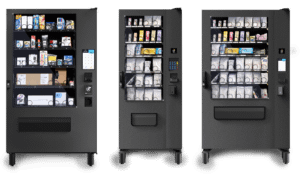Vending machine technology has certainly come a long way in the last several decades. No longer are vending machines only designed to provide you with a quick snack in between meals, or something to drink when you’re thirsty at work or school. Medical vending machines and similar types of automated solutions are making people’s lives easier across a wide range of different industries on a daily basis. Case in point: a new type of vending machine is specifically designed to provide working mothers with the tools they need to breastfeed their children while on the job.
It’s a situation that is all too familiar to women who are trying to maintain a career and raise a family at the same time: they’re on the job and ready to breastfeed, only to realize that they’ve forgotten a storage bag or a valve or some other important item at home that morning in their haste. Their child needs to eat, but they don’t have what they need and find themselves in a tricky predicament.
Thanks to a new type of vending machine technology, these fears are well and truly a thing of the past. A vending machine that was recently installed at Johns Hopkins Hospital allows working mothers to purchase a wide range of different breastfeeding tools and equipment at a moment’s notice. It is the first of its kind, though it certainly will not be the last.
The breastfeeding equipment vending machine stocks everything that a mother would need to successfully breastfeed her child, from storage bottles to nipple cream to pump accessories and everything in between. The machine was created by Mega Stoltzfus, who is employed by Johns Hopkins in the Office of Work, Life and Engagement.
Stoltzfus indicated that inspiration hit her when she was walking through an airport and realized how far vending machine technology has come even in the last decade. As someone who previously needed to work odd hours and breastfeed to the job herself, she decided to work directly with a manufacturer to design a specialized vending machine solution for people like her.
Because the type of equipment that is being sold in the vending machine is considered to be an employee benefit, it is all available at a steep discount. Any mother who finds that she needs to use the machine can pay for her items using a debit or credit card – it really is that simple.
Working mothers who are not employed by Johns Hopkins won’t have to wait long to get in on this new technology. Other institutions around the country have already expressed interest in similar EMS supply vending machines of their own.
Source:
http://www.baltimoresun.com/features/maryland-family/now/bal-johns-hopkins-introduces-a-vending-machine-for-breastfeeding-mothers-20140710-story.html
http://www.dailymail.co.uk/news/article-2708524/Vending-machines-containing-breastfeeding-equipment-rolled-Baltimore-hospital-attempt-cater-working-moms.html


